Meet a generation balancing the nation’s religious and cultural heritage with the impact of modern philosophies and issues
BY NIKKI THAPA, KATHMANDU
My work with photographer Thomas Kelly as his photo editor brought me into touch with HINDUISM TODAY some 15 years ago. Three years ago I left that job to pursue my own interests in running my website, askmeaboutnepal.com , and Healing Hands Nepal, my nonprofit organization, both of which allowed me to travel extensively in Nepal. As I traveled, my interest in Hinduism increased day by day with new discoveries about Nepal’s variety of customs, temples, culture and traditions. When I suggested to the editors that I report on these experiences, they countered with the proposal that I survey Nepal’s youth, ages 18 to 28, as a HINDUISM TODAY article had done two years ago in India.
I had the same questions: How does one tap into the pulse of the youth? How do I find the right sample? As with that article, I also concluded it wasn’t really possible to assemble a truly representative group. I ended up focused mostly on urban youth among my circle of friends and contacts. All had to be born into Hindu families, regardless of their current beliefs.
That settled, I studied the questionnaire distributed via Google’s survey platform. When I read the questions, I was stunned by their depth.
The opening question was, “Do you today self-identify as a Hindu?” If the answer was yes, the questions delved into their ideas of God and other religious practices and beliefs, including karma, dharma and reincarnation; how Hinduism manifests in their personal lives, and the differences between themselves and the older generations in their household. If the answer was no, we asked if they were atheists, agnostics, “spiritual but not religious,” or in the “I just don’t care” category. We wanted to know at what point did they become estranged from Hinduism? What issues, philosophical or otherwise, did they find troubling? How do they interface with the celebration of Hindu festivals and other events, which are so prevalent in Nepalese culture? Finally, what they would want to change about Hinduism?
Through social media, I invited a group to participate. All agreed, but only 22 completed the lengthy online form. One of them jokingly said, “Nikki, these questions are way more complicated than my final year’s math questions.”
I followed up by phone with further questions. I also conducted a few group chat sessions, because I wanted to know how one reacted to another’s point of view and in what way. I made mental notes as I ran the recordings past my sister and her friends and randomly put questions to people at my office. Note that the reports are based on city youth. Views from the rural areas likely vary sharply.
BEING HINDU IN NEPAL
One thing that became immediately clear is that despite being next-door neighbors and sharing the ancient traditions, being a Hindu in Nepal is not the same as being one in India. For one thing, at just four percent Muslim and one percent Christian, politics and religion in Nepal are not so intertwined as they are in India (which was a major complaint of the Indian youth). Ninety-three percent of Nepalese are Hindus, Buddhists or Kiratist (an indigenous religion), and these religions remain intertwined in various ways, including overlapping Deities and in the celebration of festivals. Religious tolerance is so strong in Nepal that any religion’s festivals are equally celebrated by everyone.

When King Prithivi Narayan Shah unified Nepal into one nation in the 18th century, he declared Nepal as the “Real Land of Hindus.” He said, “This is not a nation gained by my trifling efforts; this is the garden of all four main castes and 36 tribes/subcastes.” He urged citizens to never leave the traditional dharma of the ancestors. It is deeply relevant that Nepal was never colonized by the British, so was spared the cultural consequences of such dominance. Until 2008, Nepal was officially a Hindu nation, and politicians continue to end every speech with “May Pashupatinath [Lord Siva] always protect us.”
Here the four main castes are based on racial makeup and occupation. Brahmins and kshatriyas are Indo-Aryans; vaishyas and shudras are of Mongol ethnicity. The details beyond this broad distinction are complex and would require another article, if not an entire book, to explain. For example, the Sherpa tribes in the high mountain regions are vaishyas and follow Buddhism. The hill region tribes, such as the Tamangs and Gurungs, celebrate Buddhist and Hindu festivals and have their various life rituals performed by lamas. The Magar tribe (mine) is totally Hindu, with our life rituals performed by brahmins. The Newars, the natives of Kathmandu Valley, are Hindu and Buddhist in equal ratio. All these castes and sub-castes speak their own regional languages as well as Nepali, the official language.
With religion come superstition and orthodoxy as a package deal. Some are fun to follow and others are not. We don’t wear newly bought clothes on Mondays, because we believe the clothes will tear easily if worn first on that day. Wednesdays are considered “Late-days;” no new task is initiated on this day. It is inauspicious to buy or move to new houses on Tuesdays or Saturdays, as these days are ruled by malefic planets, Mars and Saturn. Seeing sandals placed upside down or empty water vessels sitting outside one’s house when departing are inauspicious signs. One should fix the position of sandals and fill the vessel (meant for passers-by) before embarking on a journey. A curious one is when a cat crosses our path we are supposed to stop and wait for someone else to pass first. There is no valid explanation to any of these customs, but we continue to practice them.
Girls are banished from their residence for 14 days when they get their first period, menarche, because they are supposedly impure at that time. The banishing event recurs every month for four days during the menstrual cycle. All Hindu households practice this exile moderately, but girls in the mid- and far-western regions of Nepal are forced to live in a cattle shed—a practice called chaupadi. This harmful practice has been outlawed because of its impact on mental and physical health, but it still persists due to superstitious beliefs, community endorsement and gender disparity. Many of our interviewees loathe the practice, as do I.
BEING YOUNG IN NEPAL
We discovered many commonalities among the youth we spoke with. Nearly all have parents who are fairly religious, maintain a home shrine where they perform daily worship and engage a designated family priest who frequently comes to perform various pujas. None miss out on the popular festivals, which provide great opportunities for celebrating with family and friends, augmented today with the posting of hundreds of photos of the events on social media. Many youth express an aversion to the social divisions within the country and to certain practices, such as the aforementioned chaupadi. Just about everyone had watched at least some of the Ramayana and Mahabharata TV series as children. In this meat-eating country, there was a solitary vegetarian among those we interviewed.
Unlike what Palak encountered in India, where the youth were discouraged by the political exploitation of religion, I would say there was a definite positive outlook on the value of Nepalese religion and culture, one as yet unpolluted by the politicians. For example, youth from the Newar communities are working to rediscover the Newar culture, which they believe has not been adequately preserved by their parents, who did not understand its value. With that introduction, let us now meet (in no particular order) those who responded to our questions.
Sandip Maharjan
Sandip is a 22-year-old business management student at People’s College. He is a Newa Buddhist and actively blogs about Nepalese festivals, lost heritages, Gods and temples. He celebrates all the festivals, but his favorite is Indra Jatra, the biggest carnival of Kathmandu Valley.

“As a child, I loved listening to stories from my grandfather about Newari culture, tradition, festivals, and the Gods and Goddesses who protected the Kathmandu Valley in ancient times. My father, on the other hand, knows nothing about our culture. With my like-minded friends, I created two Facebook pages, Mysterious Nepal and Inherited Heritage, where we make posts about forgotten temples, history, cultures, etc.”
Sandip’s family visits the neighborhood temple every day after worshiping in their family shrine in the mornings. He loves stopping by his neighborhood temple every morning to pray for a happy day ahead. He wants to hear ringing bells, watch people do puja and see the pigeons feeding on offerings. It is one of the most majestic and relaxing sights, he says. For him, God is a source of an unseen energy that you can feel through faith and belief. God can be in any form and anywhere.
The only tradition Sandip wishes he could nullify that his parents follow is applying excessive vermilion paste on the Gods in the name of offerings. He thinks doing so degrades the beauty of beautifully carved idols.
He identifies himself as Hindu, he believes in the institution and feels that being religious fulfills him. “In what way?” I asked in a follow-up phone conversation. “I write about my religion for my Facebook page, I study a lot for that. Whenever I finish writing about one aspect, I learn about others, too. That beauty about my culture, tradition and religion fulfills me, makes me very happy. It is my cultural root which takes me back to my origin.”
If he had to change one thing about Hinduism it would be the ranking of the caste system that prevails, because he likes a world where everyone is treated equally.
Amrita Tamang
Amrita, 26, is a research associate with the Think Aloud digital marketing company in Kathmandu and an aspiring actress. Her family are vaishyas. Her parents are quite religious people who follow the rites and rituals of any normal Nepali family. But neither she nor her siblings do the daily ritual on their own.

“I don’t know if it is a surprising thing, but my parents follow both Hinduism and Buddhism. We celebrate Dashain and Tihar and, at the same time, our righteous rituals are performed by a lama according to the Buddhist tradition. So, we actually are not hardcore followers of just one religion. I even visit a church sometimes.”
Amrita has immense respect for the Hindu religion, but she dislikes the menstrual taboos. She also hates the animal sacrificing ritual at many festivals in the name of God. I asked her, “How can you eat meat and not approve of slaughtering?” She replied defensively, “I don’t eat meat by choice, I eat it because my doctor was concerned about my protein count and prescribed it to me.”
Amrita loves Tihar, the festival of lights, and the fifth day, Bhai Tika, is her favorite. They have a gathering on that day; her paternal aunts come to her house and they celebrate Bhai Tika. Making selrotis (a famed Nepalese sweetbread) for this special occasion brings her great happiness, because all her family members love eating them.
Manish Pandit
Manish is a 25-year-old teacher at the Caspian Valley College of the Kathmandu Schools of Hospitality Management, which he co-owns with his friends.
Manish’s parents are quite religious and sometimes superstitious but flexible, which he attributes to the fact that they were brought up at a time when the literacy rate of the country was very low. He has noticed that the religiousness of a person tends to increase more as they grow older, and his parents’ case is no different. He offered, “I guess people become wiser with age and experience and tend to incline more towards believing in the existence of God, so they are more drawn to religion than youngsters.”
If there is one thing he could change about Hindu customs, it would be to alleviate the physical pain that a mourner goes through during the 13-day rituals following a death in the family. Sons shave their heads, put on white loincloths and are confined to one room where they are impelled to sleep on the floor. They eat one meal a day, of rice and ghee with no salt, for the entire 13 days while they observe the death rites for their parents. Mourners are considered ritually impure, and people avoid touching them. Manish hates it that at this time of grievance when mourners need the support of friends and family (maybe hugs, too), tradition obliges mourners to go through such solitary austerities.

He is not a hardcore believer in Hinduism, but he is certain there is a powerful entity that governs the functioning of the universe, whatever it may be called. He feels there are so many aspects of life that we do not know and understand and everything around us works in so many mysterious ways, how could all this be possible without such an overarching entity.
Manish believes in karma, because nothing in life comes free. One has to pay for everything one does here; the only difference is when, how much and in what currency. If you do good, you will be good and if you intentionally do bad you must pay a heavy price.
Prajan Dangol
Prajan, 26, served as a teenage priest for five consecutive years during the Shikhali Jatra festival at the Rudrayani and Shikhali temples in Khokana. Now he is an IT engineer at Dish Home TV Station.
It’s obvious that his family is religious, given that they are priests in Nepal’s tantric tradition. They start their day with morning puja at home to Laxmi, Bhimsen and Buddha and then to Goddess Rudrayani at their family temple.
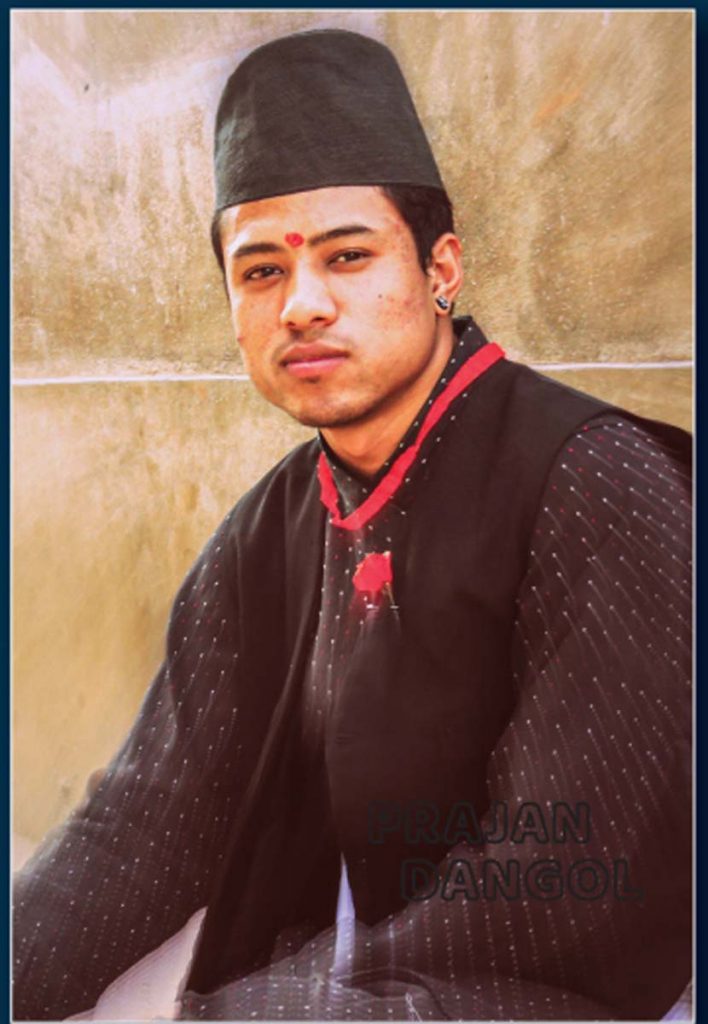
He appreciates his parents’ lifestyle; but given a chance, he would like to introduce a modern approach to fit the religion into a busy schedule, so that life and religion can coexist. He would minimize the length of rituals and the cost involved, so that everyone could fit a decent puja into their budget. There should not come a time when people avoid ancestral customs by giving excuses of time and money.
He celebrates festivals, mainly at his community temples of Goddesses Shikhali and Rudrayani. He fasts on special days for both the Deities while preparing a big puja in their honor, doing it with honesty and respect. Hinduism is an important aspect of his life.
For Prajan, God is what people believe in even though they can’t see Him. He says, “I believe in karma, dharma and reincarnation because they are the three aspects of human beings. What we do in life is karma, what we serve to people is dharma and what we get after death is reincarnation.”
Sajja Malla
Sajja, 20, is majoring in business studies at Presidential Business School. Her parents perform morning and evening puja. They do not eat until they make water offerings to God and forefathers. She doesn’t participate in everyday puja but happily follows Hinduism, which she fondly calls “my religion.” “I search for God in the images and statues at temples. I pray whenever I see one, although I am unsure of their physical existence. But I do believe in energy and consider there is a higher self. That might define the Supreme to me.”
She loves going on pilgrimage with her family and cherishes the times of visiting Muktinath in northwest Nepal and Pathivara in Taplejung district. Both temples are worshiped with equal reverence by Hindus and Buddhists.
She celebrates Teej, Dashain, Tihar, Holi, etc, but above all loves and enjoys the vibes of Tihar. “These five days make the best time of the year. The entire place is covered with lights and flowers, and everywhere people are cherishing their family and friends. The rangoli and other decorations enhance the existing joy of spending time with family, and playing cards. The sounds of the Deusi Bhailo songs and firecrackers all around add to the fun of the festival, like the icing on a cake. Besides all that, the day of Bhaitika is precious to me as it is followed by the fun of shopping and packing gifts for my brothers. It’s the festival whose preparation is as much fun as the festival itself!”
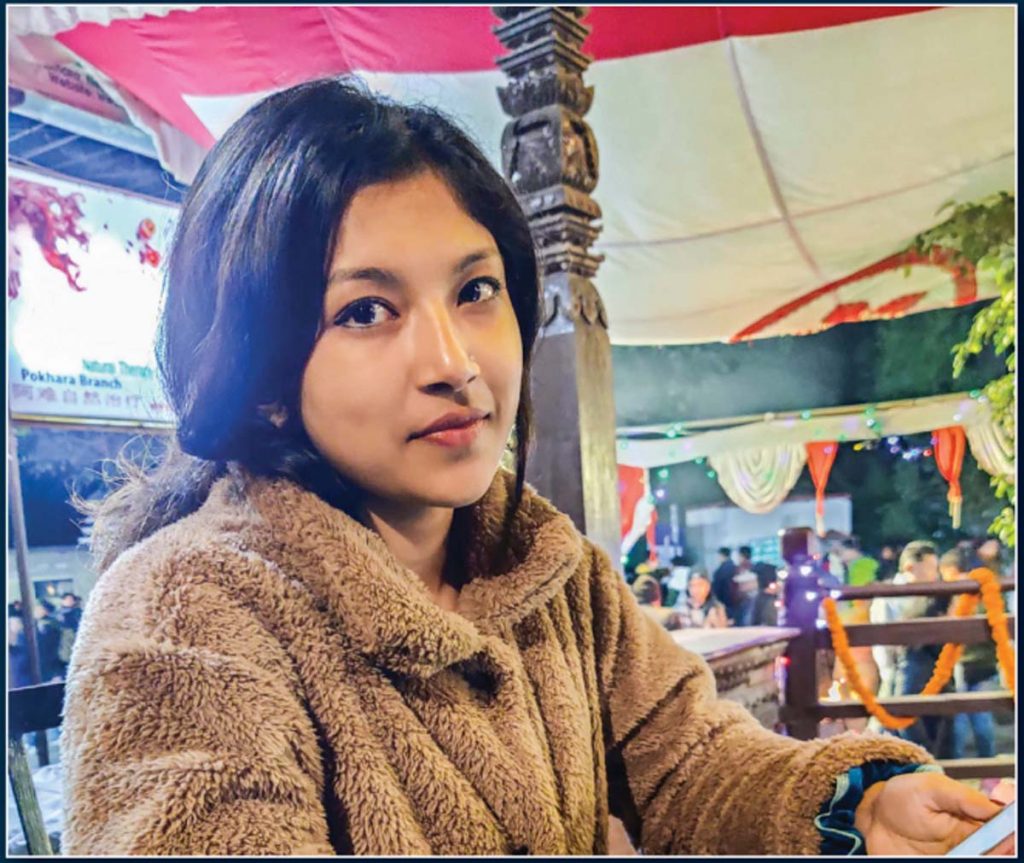
Sajja said, “I try reflecting on my actions to guide me when I am wrong. As I believe in karma, I try not to spend my energy on every bad event and let karma take charge. I am aware that you get what you give; however, I believe people should help when they can without expecting a return. Regarding reincarnation, though I have not experienced or heard of it in my personal circle, I have heard stories and I believe them.”
Sajja has suffered from migraine headaches from childhood, and practices anulom vilom (cross breathing) learned from her mother, as it provides relief. She studied yoga with Isha Foundation and benefited greatly. “Dharma, artha, kama and moksha are the four beliefs of Hinduism, which I guess not only works for Hindus. Every being ever born comes with the time they are destined with. The beginning and end are not in our hands. But the living process relies on our actions heavily. The fact that we are taught to do good deeds in life definitely influences us ethically. It leads us in a good path, and hence our actions manifest in our hereafter.” I was particularly impressed at Sajja’s level of spiritual understanding at just age 20. Most her age are into fashion, Instagram and relationships, while she is exploring her inner self.
Sajja says the one thing about the religion she wishes she could uproot is gender inequality. “Speaking honestly, I think Hinduism has been supporting patriarchal practices for ages. It has deeply implanted the idea in the society that men are superior to women, which at present has taken on new forms. I’ve never seen a female priest in a temple, and I object to widows having to remove their jewelry and colorful clothes. And I’ll certainly never understand why even today, in the name of religion, females are treated as ‘untouchables’ during their period.”
Shefali Shrestha
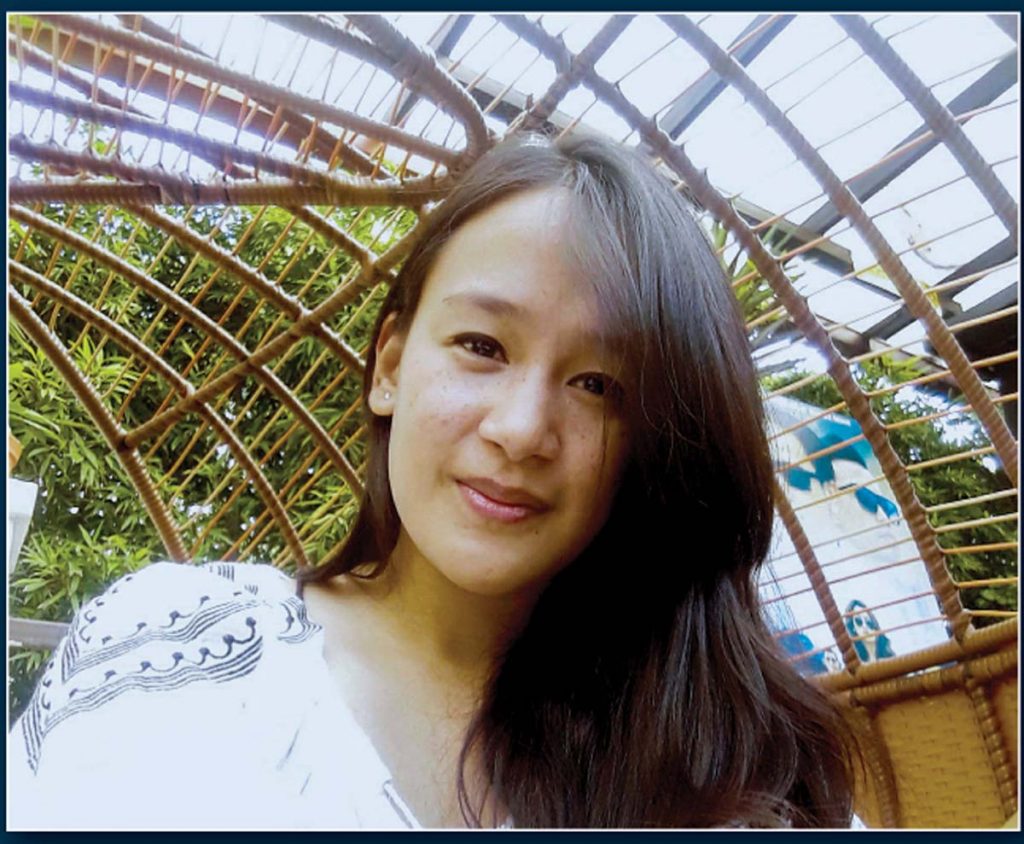
Shefali, 25, is in customer relations at a Siddhartha Bank in Kathmandu. She identifies herself as Hindu, believes in God and has faith in Hinduism. To her, God is someone who created the world and taught us to love all living beings and believe in ourselves. She says watching the Ramayana and Mahabharata taught people to respect elders, love the younger ones, have faith in oneself, be good and do good without giving up. She believes in karma—that good will return to us in some way some day.
She would not change anything about Hinduism. Rather, she feels that it’s people who need to reform their perspective on religion. “People have made up beliefs which I don’t think any religion has ever taught us. Even in today’s modern world, people are still fixated on discriminating on the basis of their caste, gender, culture, skin, class and so on, which to my thinking no religion has ever taught us to do.”
“There isn’t much difference between my thinking about Hinduism and that of my parents. I’ll be honest, they used to strictly believe in the caste system and were superstitious, but not anymore. With time, they have changed their thinking and are slowly adapting to modern traditions.”
Femita Khadka
Femita, 25, is a dental surgeon at a Nepal Medical College. Her family is very religious. Every day starts with puja, her mother fasts on Tuesdays and Thursdays, and they have a family priest conduct Griha Shanti puja trimonthly to ward off negative energy and increase the family’s prosperity. Even their birthday celebrations start with puja.
With religion comes superstition, she said. Her family forbids females entering into the kitchen or shrine during their menstrual cycle days. As an obedient Hindu daughter, it is not an issue for her to follow, but is also part of why she calls herself spiritual but not religious. As a 12-year-old girl she was treated as an untouchable during her first menstruation cycle. Out of nowhere, her parents locked her in a room for 15 days, telling her that she now was impure, and she must not let the impurities rub off on males of the family. At the end of this process, called gufa rakhne , meaning “cave retreat,” is the rite of passage when a girl becomes a woman. She dresses like a bride in a red sari. A priest conducts a puja to purify her and celebrate her stepping into womanhood.
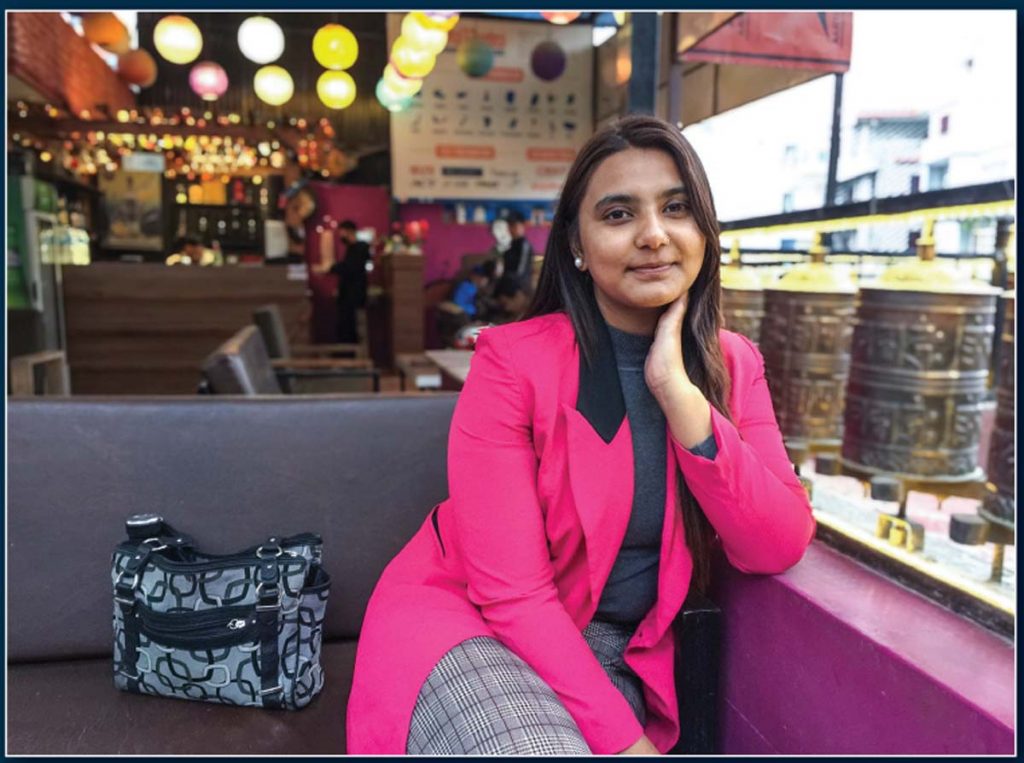
Many women fast on Teej festival without a drop of water for the whole day and faint. Her grandmother fasts despite suffering from abdominal problems. She thinks these kinds of religious traditions in the name of God are self-imposed and unnecessary. Femita doesn’t like the idea of limiting Hindu temples only to Hindus. She also doesn’t like the practice of buying overpriced small murtis of the Gods to take home.
She loved Lord Krishna’s character from the Mahabharata . “He taught us that the goal of life is to be happy and that we need to welcome every challenge patiently because God loves testing us.”
Suprim Lal Amatya
Suprim, 24, is a computer science graduate from Kathmandu University of Science who now runs an online grocery store, Ghar Aangan Service.
Suprim is born in a Newar Hindu family who firmly believe that chanting mantras while praying to God with a pure heart will rid them of pain, misery and sufferings. He feels that their prayers and daily worship at their shrine room are their greatest strength amidst their daily struggle. “They worship early morning at sunrise with the bathing of the Gods and arati. Again at dusk a puja is also done.” For Suprim, Hinduism means to carry out the daily worship and celebrate festivals with family and friends. He likes the religion the way it is.
Still, he says, “Even if I consider myself a Hindu, I’m not much of a believer. Yes, I do worship the Gods, but I don’t think I’ve got a strong faith in them.” Buddhism also appeals to him because, he says, Buddha was born as a normal prince but achieved something that no one else ever could. Thus, people consider him God, follow his path and want to achieve supreme knowledge like he did.
Suprim’s family go to temples for birthdays and festivals. He is considered the lazy one when it comes to going to temple—he pays respect from afar, looks at the temple and touches his head and chest three times in a gesture of salutation.

As with everyone else, he loves the festivals, especially the Rato Macchendranath Jatra (in April/May) when the 60-foot-tall chariot is pulled with thick ropes through the streets of Patan by hundreds of devotees. “I myself have volunteered to pull the chariot several times. During this festival, I get to meet my friends, enjoy and return home full of memories. We also organize a feast at home for our close relatives.”
Helen Rai
Helen, 24, an IT professional from Udaypur, rated her parent’s religiousness as 5.5 on a scale of 1 to 10. Her own rating is probably a bit lower. She’s the only one interviewed whose family does not maintain a home shrine or perform daily worship. She considers herself neither Hindu nor atheist: her simple answer is “I just don’t care.”
Still, Helen and her family make time to go to temples on special occasions, such as birthdays, and celebrate the festivals with relatives. But she feels forced to attend Hindu events like weddings; she says she does so because “I have no other choice.”
Helen comes across as a person who believes more in practicality than the written theory of Hinduism or any religion. She would rather learn moral behavior from religious television shows than follow a religion that comes with the baggage of dos and don’ts. And if there were one thing she would change about Hinduism, it would be the prejudice that it has created which supports sexism and racism.
Roni Shakya
Roni, 25, is a sexual and reproductive health and rights trainer certified by the World Health Organization. She works for the Mary Stopes organization (among others) promoting women’s equality and rights. Her family are technically Newa Buddhists, but like many of the Newas, they identify themselves as Hindus. Roni feels it more accurate to call herself “spiritual but not religious.” She believes in God and that His superior powers will always protect mankind in need.

Roni’s great-great-grandparents were religious for whatever reason and equally followed Hindu and Buddhist traditions. That is what came down to her grandparents, parents and eventually to her generation. As a first-born Shakya girl, she was expected to become a Buddhist nun and serve in a community temple for the rest of her life. It did not sit well with her. “I love eating, I love dressing up, I love my job, I love traveling, and at the same time I have immense respect for God, so if you let me live my life my way and serve God at the same time, I will happily serve as a nun.” Her implicit refusal created quite an uproar in her Shakya community, and the leaders are still upset with her.
As an advocate and trainer for menstrual hygiene, she objects to the customs around menstruation, such as women being forbidden to receive tika or prasad on Dashain if they are experiencing their menses. These and related restrictions, such as the chaupadi system, pushed her away from religion. Personally, she chooses to participate in all the functions despite having her period.
She is against the offering of animals at temple, even though she herself enjoys eating meat. Since there is already a system of places and people to supply meat, slaughter at the temple is unnecessary. “I am also against the casteism that is so pervasive among Hindu people.”
Tajbij Gartaula
Tajbij, 27, a social worker, was born into a brahmin family. They begin each day with worship of God, their ancestors and their family Deity, attend the temple and festivals, and go on pilgrimage regularly. “These activities show that my parents are religious and Hinduism is an important aspect of my life.” Tajbij jokingly says he likes Dashain and Tihar the most, because he gets new clothes for the occasion. Tajbij comes across as a kind-hearted person despite his masculine tone. He strongly believes in karma and takes responsibility for his actions.
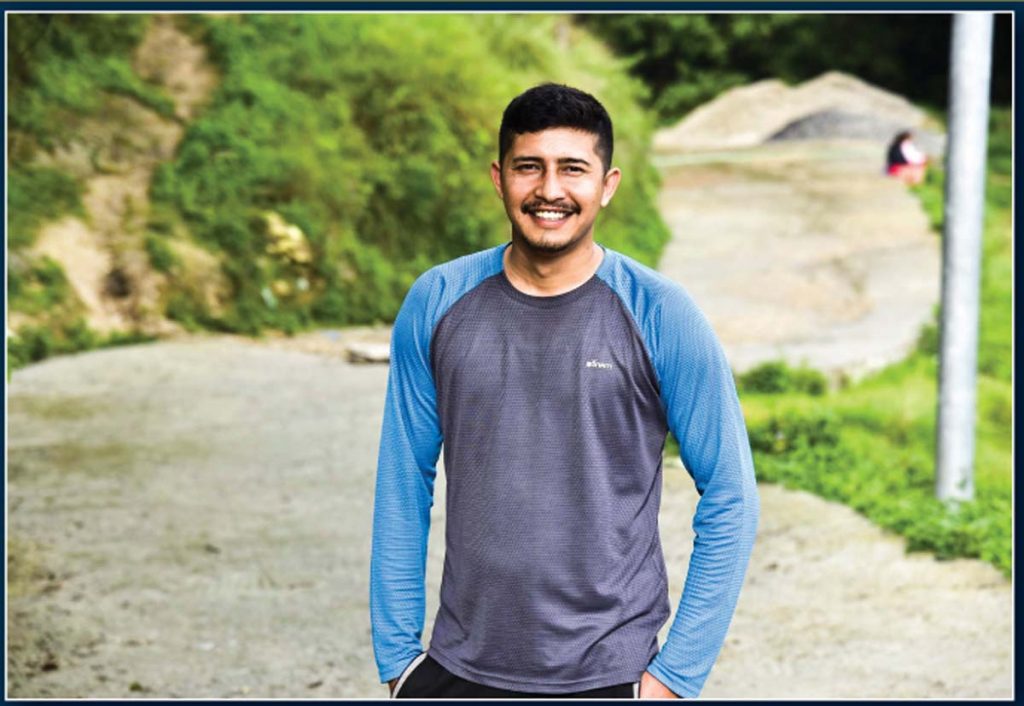
“For me God is the one who decides my future depending upon how much hard work I do to become successful. Hinduism has always taught me to respect my elders and love younger ones.” However, personally performing everyday puja at the home shrine, making mandatory visits to temples and donning the sacred thread is not religion to him—in this he differs greatly from his parents.
Astha Shrestha
Astha, 27, has just graduated as a dental surgeon but hasn’t yet found a job. Her parents are “moderately” religious. They believe in God but do not perform any elaborate rituals, nor offer flowers, oil lamps and incense sticks every morning at a home shrine. Her mother goes to the temple every Saturday, and other members go during festivals.
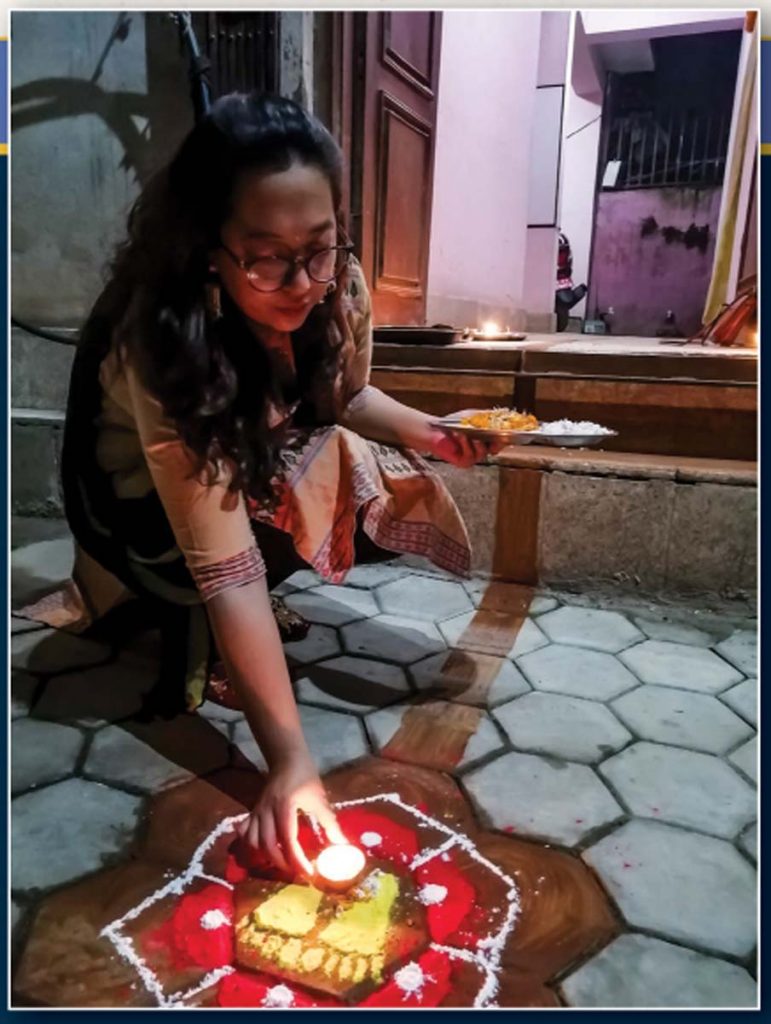
For Astha, God is a belief, a hope, a trust that keeps people sane. Hinduism is a religious institution that is very important to her, but it doesn’t dominate her life. She believes in equality and religious tolerance, “live and let live” and doesn’t agree with her parents’ bias against other religions.
“I believe that all the things we say or do have effects. So, karma and dharma have meanings more intellectually than in a spiritual way. I’m a bit skeptical about reincarnation.”
Hirmun Adhikari
Hirmun, 24, is a hotel management student who belongs to an Upadhyaya brahmin family from Nepalgunj, Southern Nepal. Upadhayaya are the highest-ranking brahmins. They are allowed to study the Vedas and become family priests authorized to perform the samskara rites of passage, such as marriage. His father, however, was a manager at the Tribhuvan airport in Kathmandu and worked 18 hours a day at his job to support the family. It left him no time for even the home rituals.
Despite being a Hindu, Hirmun went to a premier Catholic school in Lucknow, India, with both Christians and Muslims where, he says, he learned about religion and “what it is to live in a peaceful, secular environment.” As a Hindu, he folds his hands respectfully in namaste when his mother does puja at their home shrine or twice daily recites the prayers given by their priest. He loves celebrating festivals, praying to God and going to temples in search of inner peace and the path of truth—what he calls practical Hinduism, whose principles he respects. But, he says, he “does not pray the way the Hindu books want us to.” Also, “to be honest, I have no knowledge about karma, dharma or incarnations. These are, from what I’ve heard, the essentials of Hinduism.”
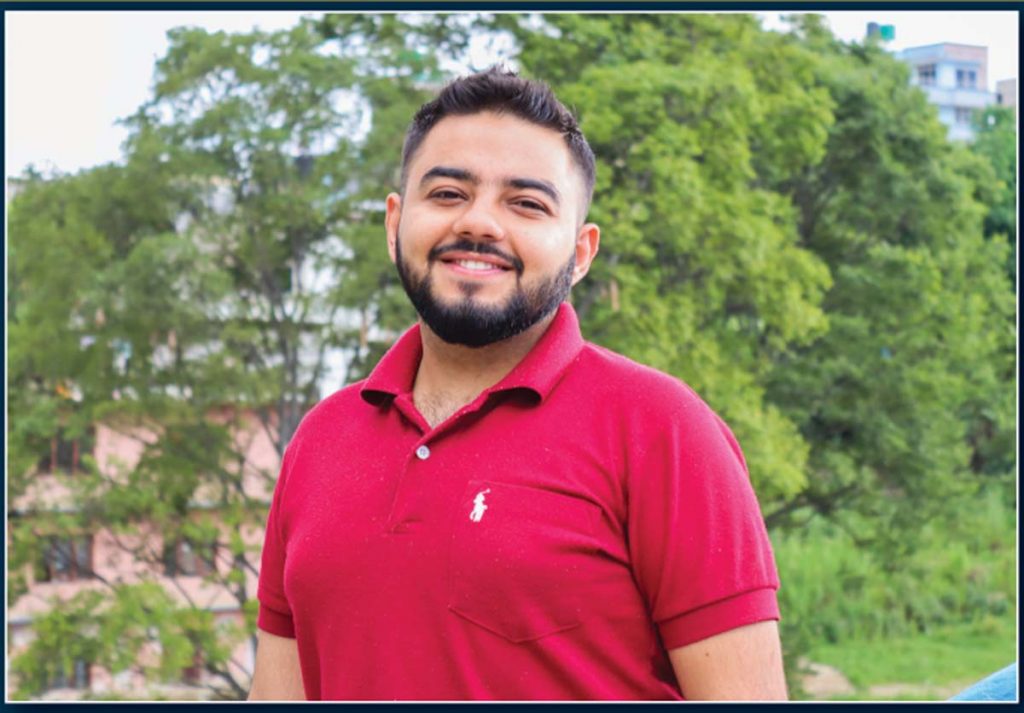
His parents have been to many pilgrimage destinations in India, but he has only gone to Ayodhya and Varanasi. He would have preferred to go hiking with his friends in the mountains but was instead “dragged to Varanasi” by his parents. Once there, though, he become enamored by the spectacular evening Ganga arati (worship with oil lamps) at Dasawamedh Ghat and forgot what he was complaining about. He attended three evenings of worship and ever since has felt a special attachment to the holy city.
He thinks that God is a term given to us to make us believe there is something in this world that helps us in the form of energy. He sees little value just in Hinduism being the oldest religion, especially when that’s taken to mean it shouldn’t change. He finds it illogical that Hindus are allowed to eat certain types of animals but not others.
Hirmun complains about Hinduism being used for political purposes, personal gain and business. He feels the various festival rituals are losing their originality by being modernized wrongly.
When asked what he would change about the Hindu religion, he said, “I would change the inferiority complexes and restrictions. The world is moving faster, and there need to be some changes that fit with us. Religion is made for us; we are not made for religion.”
Neelam Ghale
Neelam, 27, is an English teacher who comes from a moderately religious background. Her parents perform daily worship at home, fast on certain days, visit the temples and celebrate the festivals. As a Hindu, she doesn’t eat beef, because it is the symbol of the Goddess Lakshmi (as well as the national animal of Nepal).
For Neelam, God is divine and Hinduism is her way of living and belief. She maintains a home shrine of her own at her new home, following her and husband’s family’s tradition. She also offers water to a peepal tree (Ficus religiosa, under which Buddha found enlightenment) as did her parents. She follows these religious activities as a conscious life style choice, while her parents took it as compulsion.
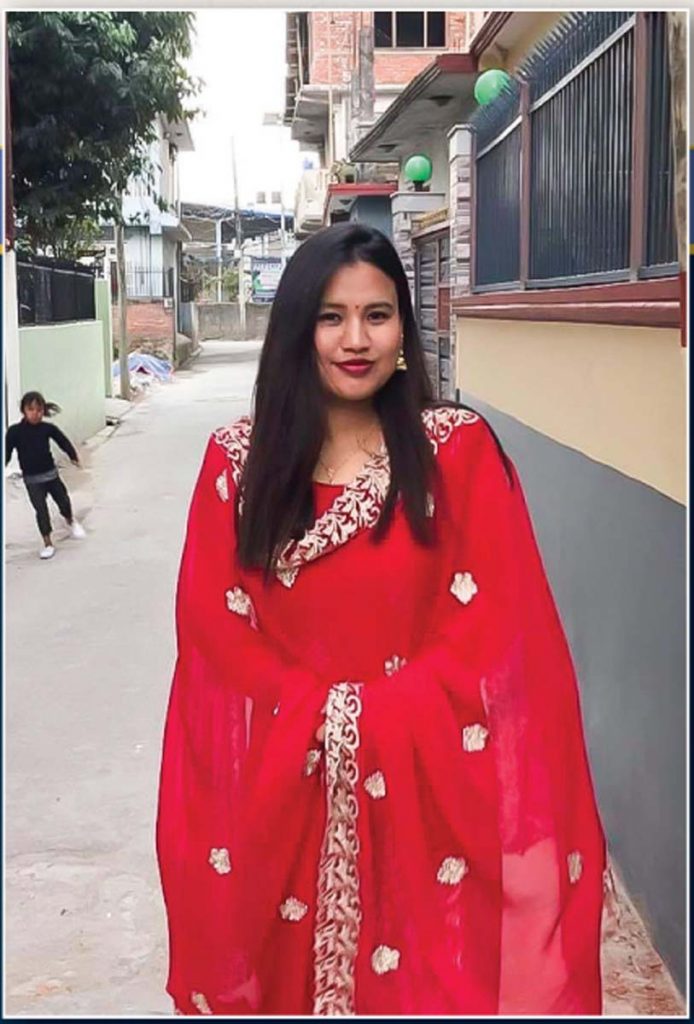
Himani Shree Pokharel
Himani, 22, comes from a brahmin family of Khandbari Sankhuwasabha district and is presently studying public health in Kathmandu. “My mother is a religious woman,” she explains, “and has strong faith in God and the culture she inherited. She fasts, holds pujas and performs all the religious activities. My dad is very supportive of her.”
Her father taught her and her brother meditation from a young age to connect them to the spiritual self and also as a mental discipline. But she finds the meaning of meditation has changed course for her as she grew older and continued her journey of self-discovery. It has shifted to finding time to do things that give one joy. For Himani, that became doodling, painting, reading and so on.
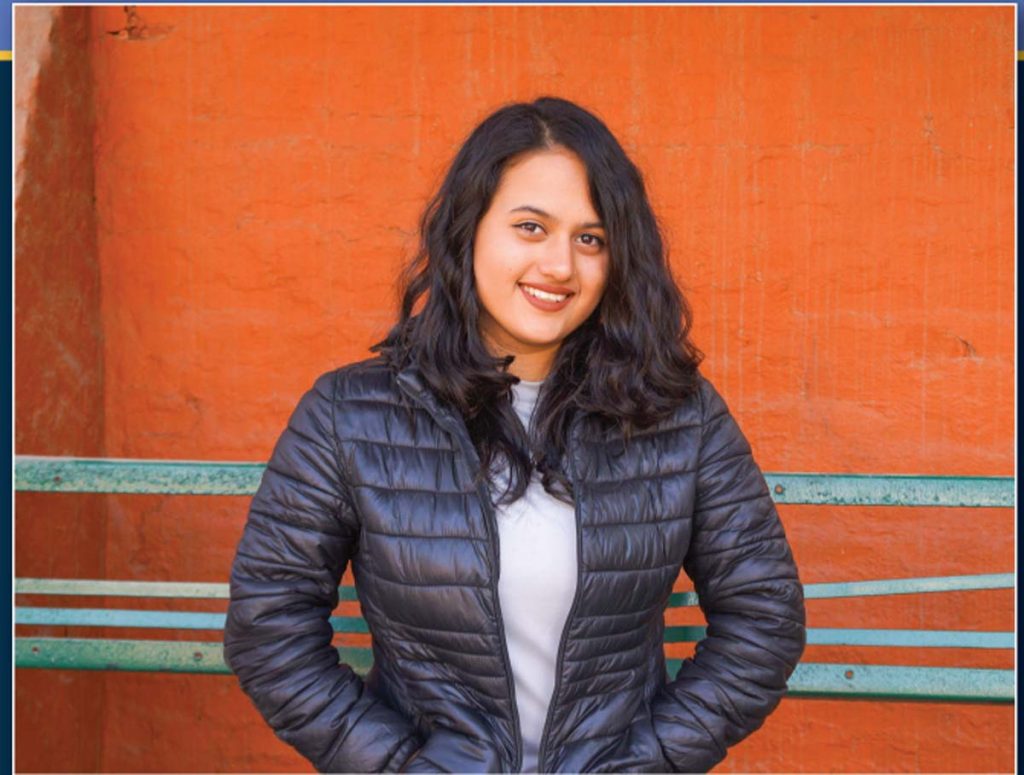
Himani self-identifies as a Hindu. She likes going on pilgrimage. She has been on many in Nepal with her family, and there are Indian destinations on her bucket list. At temples, she finds peace in the smell of incense, ringing of bells and enchanting atmosphere. Like everybody else, she loves Tihar, making rangoli, lighting oil lamps, singing Deusi Vailo songs and enjoying the special foods. Religious TV programs, such as the Mahabharata and Ramayana, taught her to be honest.
“Hinduism is an important aspect of my life because it has contributed a lot to the person I am today, be it my morals, values, empathy, kindness and so on.” But she wouldn’t follow anything that she can’t comprehend simply in the name of religion. She would impart the same to her children, if she has any in the future. “I would be very happy if my children followed my religion and tradition without me having to force them.”
“God is someone who guides us through this journey of life. They don’t necessarily have to be a single person or an all-powerful being. As the concept of God is different for everyone, divine forms may be different for everyone. I have always kept my faith apart from what I learn in school, so I don’t think the two worlds ever got a chance to collide.”
Achyut Kiran Adhikari
Achyut, 21, from Gorahi Dang is a medical student at Kathmandu University of Medical Science. He belongs to a fairly religious family and enjoys all the holidays, especially Holi, because he loves playing with the colored powders.
Achyut claims that he learned moral values, religious principles, standing up for one’s rights, being truthful to oneself, kindness and forgiveness from religious TV programs. That doesn’t mean he follows all the customs, like his parents tend to, just because something is tagged as religious. He likes to do his own research, correlate things with science and then may apply those he feels are good.
He says, “God is the Almighty that is above all the explainable as well as unexplainable forces. I don’t think of a particular person or an image as God but rather as a virtue that helps me walk in the right track.” He worships his God every day with rice, flowers and incense. When he has time, he visits nearby temples to gain inner peace. Achyut practices meditation as taught by his grandparents. He chants Aum, which he believes vibrates even in the vast nothing. He claims the chanting brings him nearer to himself. “Karma is what we do, dharma is what we should be ideally doing. Regarding reincarnation, I believe that though the physical form can be destroyed, the soul cannot. So, yes, a soul might take another body and reincarnate.

“Hinduism, the Sanatana Dharma, is itself quite scientific, but the addition of things through time for someone’s selfishness has corrupted its real values. I would like to have a thorough research done, because there are a lot of things we still have to know about Hinduism.”
COMPARING TO INDIA’S YOUTH
This article was developed along the same lines as H INDUISM T ODAY’S 2019 piece, “Hindu Youth in India Speak Out about the Role of Religion in their Lives,” written by Palak Malik. An obvious question at this point, then, is: “How do the youth in the two countries compare?”
While the two nations are adjacent, their histories are quite different. Nepal was never colonized or subjected to Macauley’s education system. Conversion to another religion was illegal until 1990, and the country was officially Hindu until 2008. Neither Islam nor, until recently, Christianity, have had a noticeable presence.
Compared to Indian youth, we found Nepalese youth are more observant Hindus. For us, Hinduism manifests subconsciously in our everyday life when we go to the temple or participate in festival celebrations, and those experiences continuously nurture our cultural values. At the same time, a deep understanding of Hindu philosophy is rare here. There is only a meager chance that you will find a book written in Nepal dedicated to Hinduism. Usually there are just sporadic mentions of our religion in books on Nepali festivals and culture. We are more concentrated on how our festivals and cultures formed, what era they came into existence and how to preserve our heritage and long-lost art styles. Most of us would rather watch the Ramayana or Mahabharata on TV than read the books in print, even the Bhagavad Gita . The only holy book we want to read is Swasthani Brata Katha , which we do in a ceremonious manner each year in the month of Magh (January/February). It is the story of the Goddess Swasthani, a form of Shakti, and derived from the Skanda Purana . It is very dear to us as it is very Nepalese, unlike the aforementioned epics.
Many Nepalese youths said they are both learning and unlearning how Hinduism guides their life. They are questioning the blind practices their families have followed for generations, blending in modern ideas to walk the path of spiritual awakening. They want to discard or modify customs such as chaupadi and patriarchy that were introduced here in the name of religion. The new generations want to make changes in the culture introduced, not in the theoretical philosophy of Hinduism.
There is no denying that Nepal is an underdeveloped country. People are still dependent on family; individuality has not yet fully developed. The power of voicing an opinion, other than on politics or gender disparity, is a new idea for us. Still, I was impressed by how articulate some of the interviewees were. I realize that you, our readers, may find the answers under-thought because you are more exposed to those of Indian youths, who are advanced by a 1,000 miles over the Nepalese. But for me as a Nepali, I am very encouraged by their insightful responses.
CONCLUSION
Many people opened up their heart for this article giving their honest take on Hinduism and religion. Most said yes, we have to save our tradition, go back to our roots, keep the activities alive and pass these values on to our children. There were few outright rebels against Hinduism. Everyone seems to know how to blend their secular/modern approach into their parents’ way of following traditions. Everybody enjoys festivals, especially the two biggest, Dashain and Tihar, which we call “Dashain Tihar” in one breath. Here in Nepal, coming together as a family to celebrate festivals is being a Hindu.
The idea of yoga as a spiritual practice is still nascent here, but yoga as a fitness regime became popular long ago when Baba Ram Dev appeared at wee hours in the morning on TV, forcing all the obese ones to lose weight.
I was pleased that almost all believe in dharma and karma—that “What goes around comes around.” What the next generations need, in my opinion, is to become morally sound and keep their heritages intact as they make choices in life.
I think even when they say they don’t believe in God and don’t worship God in the traditional way their parents do, the fact that they go to temple for “inner peace” shows that deep down they perhaps unknowingly believe in God. Otherwise, why would they find peace or think that energy is balanced at His door?
The Author

Nikki Thapa is a graduate in business management. She is an expert photo editor and worked with photographer Thomas Kelly (well known to HINDUISM TODAY readers) for many years as his photo manager. Her many talents include documentary making, book design, photo exhibitions and website content. Her website, www.askmeaboutnepal.com, is a rich resource on Nepal’s culture, traditions and food. She leads twice-yearly dental medical camps with German dentists under her Healing Hands Nepal NGO. Contact: nikkithapa@gmail.com.
Nepal’s Fulsome Festival Calendar
Not a single month in my country passes without the celebration of a festivity of one sort or the other, nor is there a single locality without its own way of celebrating major festivals or the traditional procession of a local Deity. Ninety percent of our festivals are religious, or, more accurately, begin with religious ceremonies, shift to spirited celebration in the streets and end with friendly feasting and fun with friends and family. This has been our way of celebrating since time immemorial.

Here’s a list of the major festivals ( jatras or chad parva in Nepali), celebrated either nationwide, in certain regions or by specific ethnic groups, but all on a grand scale. We follow the lunar calendar, so festival dates change each year, and even get adjusted midyear in some instances.
We start, of course, with New Year , which is the first day of our month of Baisakh and falls on April 14 in 2021 (all dates here are for 2021). It’s a public holiday celebrated by each of the various communities in their own way, with the festivals in Bhaktapur the most famous and boisterous.
Next comes Mata Tirtha Aunshi on the new moon of April (the 21st this year) during which everyone pays homage to their mother, either in person or, if she’s passed on, through prayers to her spirit at Matatirtha Pond on the outskirts of Kathmandu, or at the Pashupatinath Temple. We call this Mother’s Day here—it predates the Western holiday by centuries, but the idea is the same.
Buddha Jayanti (literally “Buddha’s birthday,” but also the day of his enlightenment and death), May 26, is a national holiday and celebrated by many Hindus as well. On Guru Purnima , July 24, we honor our teachers, but it is not a national holiday. For Janai Purnima on the full moon day of August, those wearing the sacred thread, janai , will change them. It’s a public holiday celebrated nationwide by eating kwati, a soup made of nine types of beans. Everyone ties a sacred thread called doro around their wrist to purify their soul and protect them from harm. Like the Indian festival Raksha Bandan, it honors the bond of love and affection between brothers and sisters, with sisters tying the colorful rakhi bracelet on their brother’s wrist. It is an auspicious time for Nepali Shamans to perform rites at Kumbeshwar in Patan, Gosaikunda in Langtang and Charikot in Dolakha.
The following day is Gai Jatra, the cow festival, in Kathmandu Valley, a public holiday to commemorate the death of loved ones.
In addition to Mother’s Day, we also have a Father’s Day, Kushe Aunsi (not derived from the Western holiday, which is even more recent than Mother’s Day), an ancient festival to show respect and gratitude to one’s father and ancestors. It’s on September 7 this year, celebrated by everyone, but not a public holiday. If the father has passed on, the shradda , yearly death rituals, are performed.
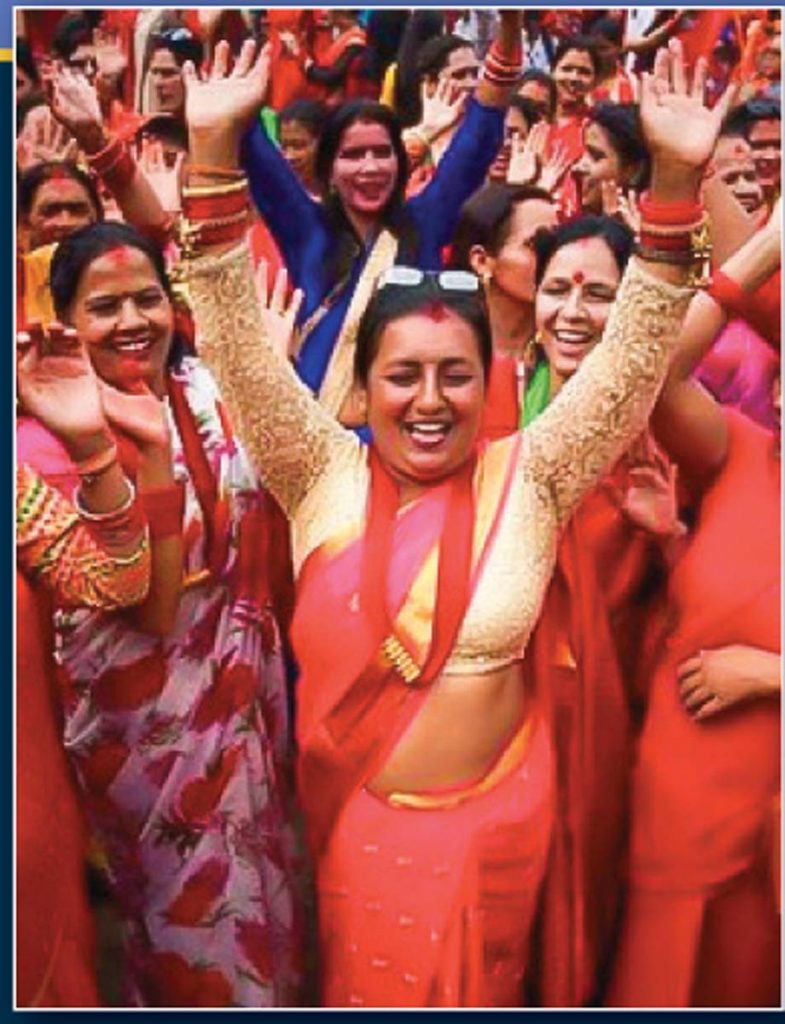
Haritalika Teej , or just Teej, is Nepal’s well-known women’s-only festival, a national holiday in which all dress in red. It falls on September 9 this year on. Married women fast and pray to Lord Siva on this day for their husband’s well-being and long life, while unmarried women fast in the hopes of getting a suitable match like Lord Siva. Two days after Teej is Rishi Panchami , also a festival just for women. On this day we pray to the Sapta Rishis and Arundhati, wife of Vashistha, who devoted their lives for the well-being of mankind and society. All women, including girls who have experienced menarche, take part in the worship, seeking forgiveness for any errors committed during their monthly periods.
The eight-day Newar community festival of Indra Jatra , which takes place in September this year, is to thank the God Indra for abundant rain for rice cultivation. It’s the biggest street festival of the year, featuring masked dancers and the procession of the royal Kumari, along with Gods Bhairabh and Ganesh, through the ancient areas of Kathmandu. The last day, the 23rd, is a public holiday.
Dashain , which corresponds to Navaratri and Vijaya Dashami in India, is here a five-day holiday, this year from October 12 to 16, and the biggest for all Nepalese. As in India, it honors Goddess Durga and involves lots of family gatherings and feasting. A few weeks later, November 2 to 6 this year, is Tihar , the second-biggest national festival, involving the worship of crows, dogs, cows, oxen and the Goddess Lakshmi, with the fifth day being the festival of brothers and sisters. The last three days are national holidays.
The Chhat festival in early November is the biggest festival of Southern Nepal’s Terai region. It centers around the worship of the Sun God and His sister Chhati Mai. Maghe Sankranti, in mid-January, marking the end of the month with the winter solstice, is a special day for the Tharu community of Southern Nepal and the Magars.
Of course, in this land sacred to Siva, Maha Shivaratri is celebrated nationwide, this year on the night of March 11, just as it is across the Hindu world. Fagu Purnima is the national spring festival—Holi in India—and celebrated the same way with the tossing of colors upon everyone.
In Ghode Jatra , “Horse Parade Festival,” the Newars of Kathmandu pay homage to the local Goddess and enjoy family feasts. The Nepal Army’s horse races at Tundikhel ground are a popular event. It is officially the last festival of year; this year on April 11.

Very well written. Got to know a lot about Nepalese Hindus and their traditions. I am an Indian Hindu and I just recently got to know about Hinduism today magazine. Btw, The article about Nepalese Hindus was very well written and I hope I’ll know more about Hinduism worldwide through this magazine in the future.
Thank you Harshit, kind words are very encouraging.